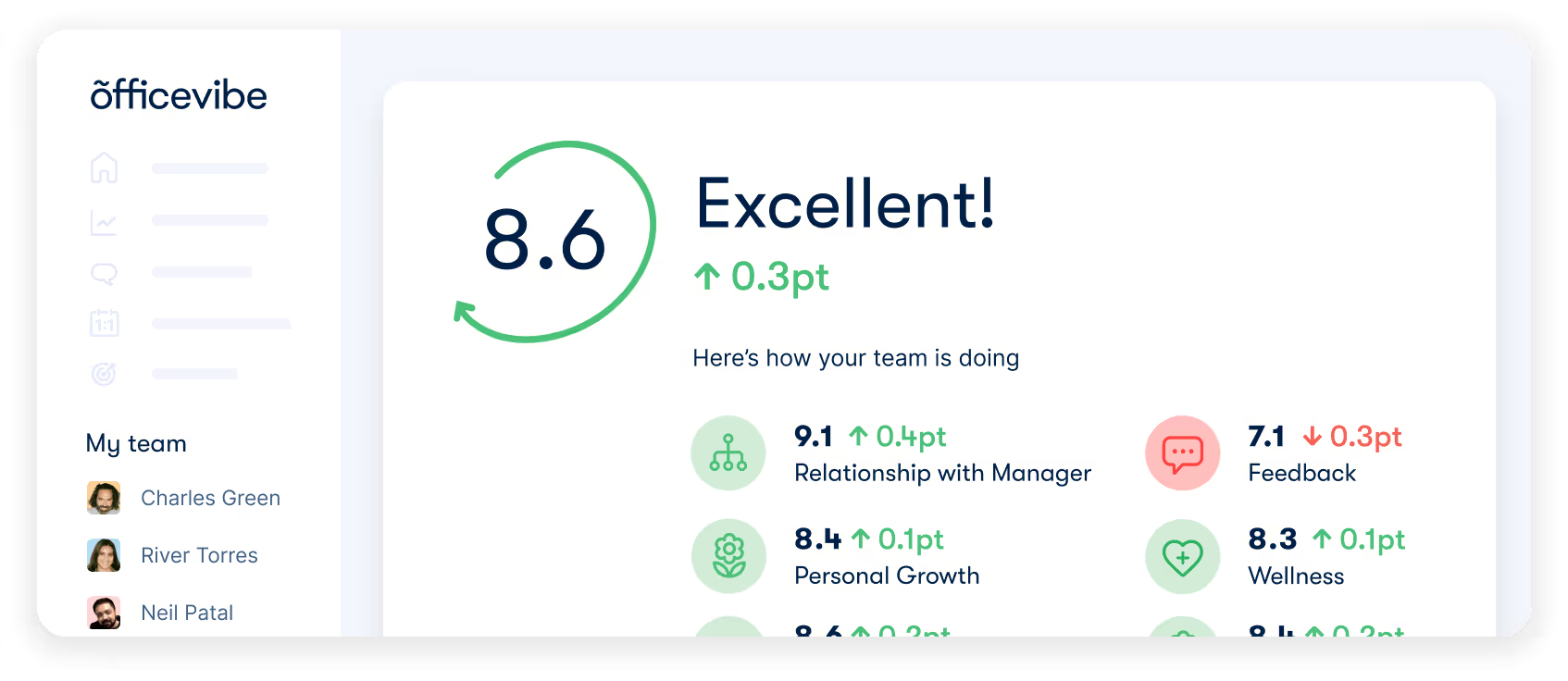6 proven solutions to common distributed teams challenges

Discover Workleap Officevibe's benchmark report on 12 key employee engagement metrics

Fact: the modern workforce is filled with more dispersed teams than ever before.
The people have spoken.
Flexibility, increased wellbeing, and time saved without a commute are the most commonly cited advantages for remote workers. But with these 'perks' also comes the responsibility of employers to take a deeper look at the day-to-day distributed team challenges.
They might seem benign on the surface, but if not proactively addressed, they can hinder performance, engagement, and even drive turnover. There are new rules (and tools) that employers need to get on board with if they want to keep their distributed teams intact and attract top talent in this ever-competitive hiring landscape.
We look at the most pressing issues of distributed teams in today’s workforce, along with proven solutions that dispersed teams can put in place for a successful year ahead.
{emphasize}
6 Common challenges for distributed teams, and how to fix them:
- 1. Feelings of disconnect among the team
- 2. Productivity issues
- 3. Difficulty maintaining culture
- 4. Decreased oversight & communication
- 5. Less creativity & innovation
- 6. The loneliness epidemic
{emphasize}
6 common distributed team challenges (and how to fix them)
1. Feelings of disconnect among new and existing team members
Challenge: A common distributed team challenge is the “connection gap”. The ability to build and maintain genuine connection with people in the workplace from behind a screen.
There’s nothing like showing up to the office building on Monday morning and chit chatting about the weekend over a morning coffee, or lunching with colleagues from other departments, engaging in inspiring conversations that spark new ideas.
These moments of sporadic connection enhance team dynamics, humanize work, build a sense of belonging, and create collaborative bridges from one team to another. On the flip side, working remotely can create silos: we often lunch alone, and we rarely “see” team members from other departments.
Solution: Leaders must be mindful of this “connection gap” and be intentional about virtually simulating scenarios where people can interact genuinely. Thoughtfully investing in moments for virtual teams to come together for in-person workshops, bonding experiences, and strategy sessions can be a budget and coordination challenge. But, these moments are critical in creating company ambassadors, driving engagement and performance, and mitigating employee attrition.
What can’t be done in person, should take place virtually. Ultimately though, it’s a mindset. Do not neglect to prioritize human connection, because the work will always prove to be better and more innovative when connection and trust is at its base.
2. Productivity issues
Challenge: Productivity issues don’t necessarily refer to your employees’ inability to manage their time. In fact, many employees report feeling more productive working remotely! Where productivity issues creep in are at the process level.
When there’s no unified “code of conduct” for how to work remotely, teams risk working in different ways across different tools. These norms and tools ensure that every team works from the same baseline. And this cuts out any unnecessary confusion, so employees can focus on delivering great work.
Read more on Officevibe's distributed teams best practices and what makes the way we work unique.
Solution: Take the time to set meaningful norms and choose your tools for working remotely. Working norms refers to guidelines for how to work best together. For example, we determined that meetings can only be held between 10am - 4pm to leave time for focus work at the beginning and end of the day.
When it comes to tools, here’s what we use internally:
- Slack for daily communication tool
- Jira as one of our main project management tools
- Microsoft Teams for internal video meetings
- Zoom for external video meetings
- Confluence and SharePoint to save documents and record learnings
- Miro as an asynchronous collaboration tool
- Officevibe for effective distributed team management

3. Difficulty maintaining team and company culture
Challenge: For companies that shifted from working in the office to remote work, it’s important to recognize that your culture will not automatically transfer. Effort needs to be made to keep it alive and reflected in your remote team and company’s new work reality.
Here’s the thing: culture will happen no matter what, so it’s important to be intentional about it if you want to get it right.
Modern employees expect that the values a company preaches are brought to life in their organizations day-to-day operations and the way they're managed. But the shift to distributed teams has in many instances let culture fall through the cracks.
Solution: Take stock of how you were living your values while in the office. Ensure that whatever was not transferable to a distributed workplace is re-imagined to function in a remote reality.
Leaders and team managers need to ideate on how values will be lived and experienced across their remote teams in a way that feels genuine. Don’t be afraid to set up new traditions, reflect on whether your current values are still relevant, and even ask your employees for input. It’s the glue that will hold your distributed team together.
4. Decreased team oversight and communication
Challenge: No more water cooler chat, hallway banter, or a quick “pop in” to your manager’s office. All communications in a distributed workforce are now planned ones, meaning there risks being less of them. This poses a “threat” to the oversight managers have on their team’s wellbeing and engagement. Informal communication opportunities like those sporadic check-ins were a helpful lens onto how people were doing, and what they needed.
Solution: With the shift to distributed work, the benefits of pulse survey and feedback tools have become a remote work essential (if not saving grace) for team and company leaders. Officevibe lets leaders collect real-time data on how their people are doing, and what they really need to be successful and happy in their roles. Basically, it allows problems to surface before they become big issues, and also gives a safe space for employees to communicate their feedback whenever they have something on their minds.
It’s the virtual version of “my door’s always open,” leaving communication lines widely accessible.
The shift to distributed work comes with a handful of new communication challenges. Use an employee experience tool like Officevibe to give your team members a safe space to share their thoughts and feedback!
5. Less creativity and innovation in brainstorms
Challenge: There’s nothing like an in-person brainstorm. Post-its flying every which way with innovative ideas that spur creative discussions. This was when greatness happened. While we’ve been able to bring brainstorms from the whiteboard to a Miro board, the tool itself (while fantastic for facilitating these sessions) is not enough. The missing link to innovation is the inspiring human dynamic, which distributed teams need to foster, even between screens.
Solution: Jumping from one video session to another throughout the day can be an inspiration killer and a drain on your creative juices. If you’re hosting a team brainstorm, we suggest taking a moment before getting started. People share the most when they feel they’re in a safe space with trusted individuals. If you want to unearth the wacky ideas that lead to innovation, set the tone. Get human.
Icebreaker questions to loosen up the team:
- What colour would best describe your mood today?
- If you were to write a book, what would the theme be?
- What’s something you think your team does really well together?
{emphasize}
Our favourite creative prompt to get you thinking out of the box:
“Imagine you're Michelle Obama or you work for her, what would your idea be or what would you pitch to her?” Have each team member take a spin at this exercise.
{emphasize}
{emphasize}
Expand your mind and take it to unexpected places:
Select a random object (could be anything from an apple to a paperclip) and ask the team to brainstorm on the different ways this object can be used. It might start off practical, but the longer you spend on this the more creative the ideas will get.
{emphasize}
6. The loneliness epidemic
Challenge: We’ve spoken a lot about connection in this article. The importance of scheduling time for virtual teams to connect on a personal level can't be overstated. It ensures that team dynamics and collaboration are optimized. In the same vein, leaders need to have the awareness that people’s lives have changed outside of the workplace.
Many people relied on the socialization they had in the office.
While the bulk of people prefer remote work, many still do not. Without being able to see people at the office, it’s hard to know how people are feeling holistically. It’s hard to determine work-life balance, and how people are faring working from home full time.
Solution: The best tool for checking in on your people in a meaningful way is one-on-one meetings. These meetings should occur weekly, and allow a safe space for employees to get real. While one-on-ones are important for discussions around performance and development, checking in on a human level should always take precedence. The great thing is that these transparent, vulnerable moments help build great trust between leaders and their team members. The power of asking “how are you?” can go a long way.
Officevibe’s one-on-one feature allows both managers and employees to share their talking points ahead of time. It even prompts managers with great questions to ask their team members to check in. Below are a few questions from our software that we think might be helpful for you.
{emphasize}
Officevibe 1-on-1 prompts to check in on your people:
- How are you feeling today?
- How have you been feeling over the last couple of weeks?
- Are you feeling overworked or overwhelmed with work?
- What can I help you with?
- What’s your current state of mind?
{emphasize}
The distributed workforce model is the new normal, meaning it’s time for leaders to get on board with the new norms of virtual teams and remote work. To thrive as an organization in the modern workforce, adapting your communication technology, approach to culture and methods of collaboration are essential to remain competitive.
Give HR and managers the clarity, confidence, and connection to lead better every day.


%20(1).avif)


.avif)
.avif)








